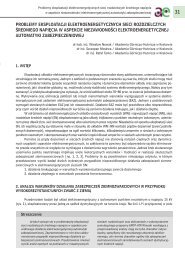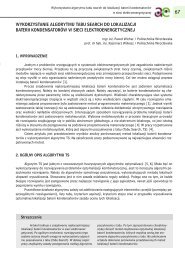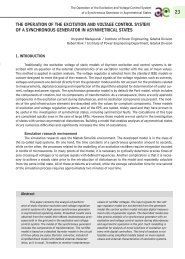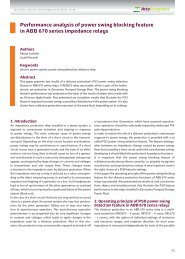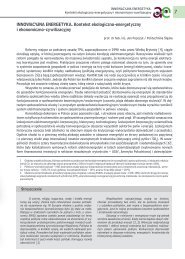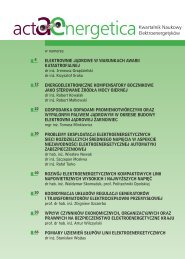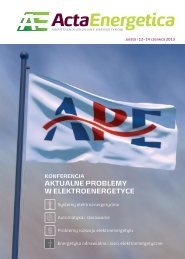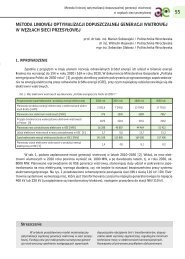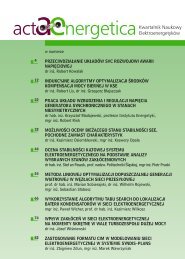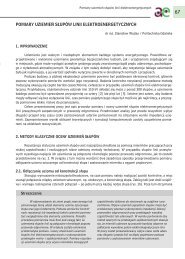76Anna Lisowska-Oleksiak; Andrzej P. Nowak; Monika Wilamowska / Gdańsk University of Technology4. ELECTRODE MATERIALS4.1. CONDUCTIVE CARBONSCarbon materials are often used for electrodes of electrochemical capacitors [5, 7, 10]. As one knows,they owe their ability to conduct electric current to the presence of graphene layers where carbon atoms C havea hybridization sp 2 (<strong>as</strong> opposed to non-conductive carbon types sp 3 ). Resistance of graphite or so-called highlyoriented pyrolitic graphites (HOPG) is high and depends on their structure and porosity.Activated carbons are materials of very well developed surface. In a technical scale they are obtainedfrom natural materials i.e. fossil fuels and organic substances (e.g. wood, fruit stones, nutshells). In laboratoryconditions also sucrose and synthetic resins are used.Available carbon electrodes can have specific surfaces area reaching even 2500 m²/g. Carbon materialis used in the form of powder, fabric, felt or fibres. Electricity <strong>storage</strong> on carbon electrodes is capacitive in anelectrochemical double layer. These are so-called electrochemical double-layer capacitors (ECDLs).Progress in the field of nanotechnology allows one to expect that in the near future application of carbonnanomaterials in the form of single-walled and multi-walled nanotubes or nanoparticles will enable obtaining ahigher specific capacitance of electrode materials.4.2. METAL OXIDESOxides of transition metals are commonly used in redox electrochemical capacitors. The most populartypes are ruthenium oxides (RuO x) [5,7] for which x value varies from 1.9 to 2.0. Specific capacitance for rutheniumoxide capacitors can even reach 720 F/g. This is the highest value of specific capacitance achieved for anyknown electrode material; however, RuO xapplications are limited due to the high cost of this material. Promisingalternatives include oxides of manganese, iron, indium, tin, vanadium and their combinations. For these,specific capacitance is around 150 F/g. A supercapacitor composed of Fe 3O 4<strong>as</strong> a negative electrode and MnO 2<strong>as</strong> a positive electrode is characterized by an operating voltage up to 1.8 V in aqueous electrolyte. Specific capacitanceof such a device is 21.5 F/g, actual specific power – 405 W/kg and specific <strong>energy</strong> – 8.1 Wh/kg [11].Oxide materials, just like carbons, are stable during thousands of charging/discharging cycles.4.3. CONDUCTIVE POLYMERSConductive polymers, also known <strong>as</strong> synthetic metals, represent a very attractive group of electrode materials,which have found application in <strong>supercapacitors</strong> [5, 12]. These are mixed electron-ion conductors. Themost popularly used polymers include polypyrrole and derivatives of tiophene. Advantages of those materialsinclude f<strong>as</strong>t oxidation and reduction processes during charging and discharging, high charge density (~500 C/g)and e<strong>as</strong>y synthesis of electrode material.Thanks to their <strong>energy</strong> accumulation properties, conductive polymers have found application <strong>as</strong> electrodematerials in <strong>supercapacitors</strong>. These can be both p and n type polymers. Rudge et al have divided polymer <strong>supercapacitors</strong>into three categories.Type I, where both electrodes are made of identical p-conducting polymer. When the capacitor is fullycharged one electrode is oxidized (positively charged) and the other remains neutral (without charge). Potentialdifference between electrodes is ca 0.8-1.0 V.Type II, where electrodes are made of different p-conducting polymers which have different oxidationreductionpotentials. Using different polymers allows enhancing the potential range.Type III – contains both p-conducting polymer (e.g. polythiophene, poly(3-methylthiophene)) and an n-conducting polymer (derivative of bithienyl). Type III <strong>supercapacitors</strong> offer a wide range of operational potentials(up to 3 V for non-aqueous electrolytes) and appropriately higher <strong>energy</strong> density.Conductive polymers used <strong>as</strong> electrodes in electrochemical capacitors may be modified in order to improvetheir operational parameters. Most often modification is made with oxides of transition metals – manganeseand vanadium. Another option is modification of conductive polymers by attaching a redox group to apolymer chain. Yet another method is the introduction of inorganic substance into a polymer matrix. This additivefulfils the role of a multicentric redox system [13-15]. There are also methods for modifying electroactivepolymers with nanomaterials [16]. In all c<strong>as</strong>es activity of the composite material is created by both electroactivematerial and the modifying agent.
Supercapacitors <strong>as</strong> Energy Storage Devices775. ELECTROLYTESElectrolyte type is another cl<strong>as</strong>sification criterion for electrochemical capacitors. Both aqueous and nonaqueouselectrolytes are used (with aprotic solvents and ionic liquids).5.1. AQUEOUS ELECTROLYTESAqueous electrolytes restrict operational voltage to 1 V, <strong>as</strong> above this value during the charging processmolecules decompose on the positively polarized electrode and oxygen is generated, while on the negativeelectrode water is decomposed and hydrogen is generated. An advantage of aqueous electrolytes is the highconductivity value (e.g. 0.8 S/cm for sulphuric acid), and simple cleaning and drying of electrode material duringthe manufacturing process. Moreover, the price of aqueous electrolytes is considerably lower than that ofnon-aqueous ones.In order to avoid problems related to decre<strong>as</strong>ing effectiveness of supercapacitor charging, high-concentrationelectrolytes are used. They guarantee sufficiently low resistance values.5.2. NON-AQUEOUS ELECTROLYTES WITH APROTIC SOLVENTSUsing organic liquids which do not contain chemically active hydrogen atoms in their molecules in the roleof solvent enhances the stability window of the system (decomposition of the solvent’s molecules does not occur).This allows achieving higher operating voltage values. The higher the voltage level, the higher the amountof <strong>energy</strong> that can be accumulated (see equation (4)). Non-aqueous electrolytes allow achieving voltages up to3 V. Higher values are prevented by traces of water present in solvents.An adverse effect of using non-aqueous electrolytes is their high specific resistance value, which affectsthe capacitor’s power. Nonetheless, the loss of power is usually compensated by a possibility to achieve highervoltage.5.3. IONIC LIQUIDSIonic liquids are salts which are liquid in ambient temperatures. A low melting point results from thestructure of those salts, which consist of a large and <strong>as</strong>ymmetric cation (e.g. 1-alkyl-3-methylimidazolium, 1-alkyl-pyridinium) and a small anion. The range of their electrolytic stability depends only on the type of ionswhich the ionic liquid is composed of. Appropriate ion selection allows constructing <strong>supercapacitors</strong> operatingin a wide potential spectrum. There are known designs where the operational voltage is 3 V. Usage of ionic liquidsis limited by low conductivity value, in the range of mS/cm. Because of this feature ionic liquids are used in<strong>supercapacitors</strong> which are operated at higher temperatures.6. SUPERCAPACITOR APPLICATION EXAMPLESElectrochemical capacitors are incre<strong>as</strong>ingly reliable <strong>devices</strong> which can work with wind turbines or photovoltaiccell systems [17]. Very f<strong>as</strong>t charging/discharging rates offered by <strong>supercapacitors</strong> allow them topromptly adapt to load changes. Supercapacitors have found applications in household appliances, electronictools, mobile telephones, camer<strong>as</strong> etc. They are also used in the power supply systems of electrically drivencars. In the automotive industry the main purpose of <strong>supercapacitors</strong> is to provide support for cl<strong>as</strong>sic batteries– they act <strong>as</strong> an additional buffer during acceleration and braking. Such an arrangement lowers operationalcosts of the vehicle, <strong>as</strong> it extends battery lifetime. Supercapacitors protect the battery from harmful effects ofpeak loads. Recovery of braking <strong>energy</strong> by <strong>supercapacitors</strong> also allows reducing operational costs by decre<strong>as</strong>ing<strong>energy</strong> consumption.



